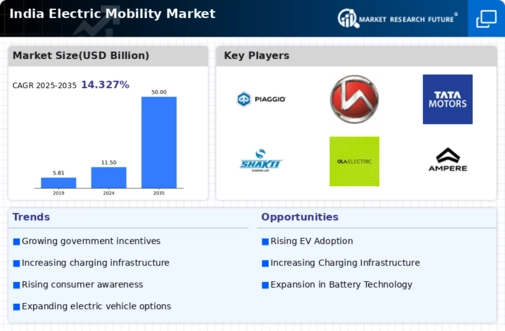Rising Environmental Awareness
The increasing awareness of environmental issues among the Indian populace appears to be a pivotal driver for the electric mobility market. As citizens become more conscious of air pollution and climate change, there is a growing demand for cleaner transportation alternatives. This shift in consumer behavior is likely to influence purchasing decisions, with many individuals opting for electric vehicles (EVs) over traditional combustion engine vehicles. Reports indicate that the electric mobility market could witness a growth rate of approximately 30% annually as more consumers prioritize sustainability. Furthermore, educational campaigns and grassroots movements advocating for eco-friendly practices are expected to bolster this trend, thereby enhancing the overall market landscape.
Technological Innovations in EVs
Technological advancements in electric vehicles are playing a crucial role in shaping the electric mobility market. Innovations in battery technology, such as increased energy density and faster charging capabilities, are enhancing the performance and appeal of EVs. The introduction of solid-state batteries, which promise greater safety and efficiency, could potentially revolutionize the market. Furthermore, improvements in electric drivetrains and vehicle design are likely to attract a broader consumer base. As these technologies evolve, the electric mobility market may experience accelerated growth, with projections indicating a potential market size of $15 billion by 2027.
Government Support and Initiatives
The Indian government has implemented various initiatives aimed at promoting the electric mobility market, which significantly impacts its growth trajectory. Programs such as the Faster Adoption and Manufacturing of Electric Vehicles (FAME) scheme provide financial incentives for both manufacturers and consumers. These initiatives have reportedly led to a surge in EV sales, with a notable increase of 200% in the last fiscal year. Additionally, the government's commitment to achieving 30% electric vehicle penetration by 2030 suggests a robust policy framework that supports infrastructure development and research in the electric mobility market. Such backing is likely to create a conducive environment for investment and innovation.
Urbanization and Population Growth
Rapid urbanization and population growth in India are driving the demand for efficient and sustainable transportation solutions, thereby influencing the electric mobility market. As urban areas expand, the need for reliable public transport and personal vehicles increases. The electric mobility market is positioned to address these challenges by offering cleaner alternatives that can alleviate traffic congestion and reduce emissions. With urban populations projected to reach 600 million by 2031, the demand for electric vehicles is expected to rise significantly. This demographic shift may lead to a transformation in transportation habits, further propelling the adoption of electric mobility solutions.
Corporate Sustainability Initiatives
Many corporations in India are increasingly adopting sustainability initiatives, which is positively impacting the electric mobility market. Companies are recognizing the importance of reducing their carbon footprint and are investing in electric fleets for logistics and employee transportation. This trend is likely to create a ripple effect, encouraging other businesses to follow suit. Reports suggest that corporate investments in electric vehicles could reach $5 billion by 2026, further stimulating market growth. As businesses align their operations with environmental goals, the demand for electric mobility solutions is expected to rise, contributing to a more sustainable transportation ecosystem.






















Leave a Comment